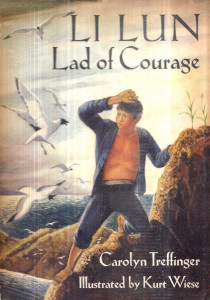< Newbery Medal and Honor Books
Given the Newbery Award's prestige it would be easy to assume that the award winners are all excellent books for children. The Biblioguides Team has not found this to be the case. We always want to provide parents with the information they need to make the best book decisions for their families. With that goal in mind, we've put together a complete list of all medal winners and honor books since inception, and the Biblioguides Review Team is working together to read our way through the winners and to provide a review. Where we have not yet reviewed a book, a description directly from the dust jacket or from the publisher has been provided. In some cases, we have shared a brief synopsis from The Newbery and Caldecott Awards: A Guide to the Medal and Honor Books (1999).
Reviews are the thoughts and opinions of the particular reviewer and do not necessarily represent all members of the team. Reviews will continue to be added as the team reads more of the Newbery books. We hope this list will help you familiarize yourself with the various winners and provide the necessary information to determine which books would be a good fit for your family!
The Twenty-One Balloons
By: William Pène du Bois
Medal Winner
Reviewed by: Sara Masarik
Also read and recommended by: Sandy Hall, Sherry Early
This little adventure novel is a magical blend of fact and fantasy. Set in 1883, the book by William Pene du Bois created a unique engineering enterprise that resulted in the discovery of a utopia settled on top of an active volcano. Beautifully, the story draws upon sensational real events and marries them with lively fiction. This little story is very clever and perfectly suited to the imaginations of “little men” in search of something wild, engaging, historical and wholesome.
Completely wholesome, highly inventive, and carefully written, this small adventure novel deserves its Newbery Medal. I was captivated by the audio and delighted by the pen and ink illustrations in my Puffin Modern Classic. I don’t think that I would love reading this one aloud, but I do think that my nine-year-old will love hiding away in a nook and reading it by himself. My younger ones (5 and almost 7) will enjoy listening to it during the afternoon quiet time.
Read full reviewThe Cow-Tail Switch, and Other West African Stories
By: Harold Courlander
Illustrated by: Mayde Lee Chastain
Honor
Reviewed by: Deanna Knoll
Recommended age: Age 8+
While studying West Africa this past year, my son and I read this book for a better understanding of the folk tales that children from this region of the world grow up listening to. Fairy tales in written form have been part of the Western culture for hundreds of years but in African countries, these stories are passed down through oral tradition only. Being able to read and access them now is a gift to us, as most of us won't have the opportunity to listen to them around a campfire in Ghana. Just as engaging as Snow White or Little Red Riding Hood, we thoroughly enjoyed reading these tales of Guinea Fowl and Rabbit and highly recommend finding a copy for yourself.
Li Lun, Lad of Courage
By: Carolyn Treffinger
Illustrated by: Kurt Wiese
Honor
NOT REVIEWED
So great was Li Lun's fear of the sea that he refused to go on his first fishing voyage — his man-making trip. Such defiance brought swift, stern punishment. Let him stay on land then, his father commanded, and plant rice — plant it on the distant mountaintop; and let him not come back until he had grown there seven times as many grains of rice as he had planted.
The chapter titles tell the story of Li Lun's trials and final triumph: Defiance; Preparation; The Climb; Night; Planting; Mildew; A Visitor; Rain; Rats; Drought; Harvest; Temple Ceremony. Here is not merely a stirring tale of the courage of a Chinese boy on a lonely island off the coast of China; here is an epic of courage anywhere.
The universal quality and high dramatic value of the story are perfectly reflected in the author's simple, beautiful style and again in Kurt Wiese's lovely pictures.
From the dust jacket
Misty of Chincoteague
By: Marguerite Henry
Illustrated by: Wesley Dennis
Honor
NOT REVIEWED
Here is an unforgettable story for boys and girls in a new and unusual setting—the little-known islands of Chincoteague and Assateague, just off the shores of Virginia. On Chincoteague live men, but on Assateague, "the isle of wild things," live the only wild ponies descended, legend says, from the survivors of a Spanish galleon wrecked there long ago.
MISTY OF CHINCOTEAGUE tells of two of these freedom-loving ponies—a strangely beautiful mare and her little colt, Misty—and of Paul and his sister Maureen, who had set their hearts on owning them. How Paul and Maureen help to capture the Phantom and Misty and then almost lose them—how they astonish the islanders by taming the untamable wild mare—and how they win their final triumph on Pony Penning Day—makes a story that is swift-moving and vividly real.
From the dust jacket
Pancakes-Paris
By: Claire Huchet Bishop
Illustrated by: Georges Schreiber
Honor
Reviewed by: Sherry Early
Recommended age: Any age
Also read and recommended by: Deanna Knoll, Sandy Hall
It’s appropriate that the story begins in the garden of “St. Julien le Pauvre” because these children are indeed poor. And it’s appropriate that there is a “light touch of spring in the air” because there is indeed springtime hope and joy to be found in the midst of their poverty. Charles, the main character in the story, is ten years old and is Zezette’s older brother. Their mother works in a factory all day, and their father died immediately after the war. The children have a discussion in the beginning of the book of how it was BEFORE, but some of them can’t even remember a BEFORE and doubt that it ever existed. This is post-World War 2 Paris, and things are difficult—no fuel, little food, no money–but hopeful. After all, it’s almost Lent, and some of the children remember having crepes (pancakes) on the Tuesday before Lent—BEFORE.
The story goes on to illustrate the friendship between the French and their American liberators and the impact of a simple gesture of kindness.
Read full review
The Quaint and Curious Quest of Johnny Longfoot
By: Catherine Besterman
Illustrated by: Warren Chappell
Honor
NOT REVIEWED
One beautiful day, when the sun was as bright as a new-polished shoe, Johnny's father said, "Johnny, my son, my only shoemaker's apprentice and Shoe King's son, it is dark and damp in our basement shop, and I see that your cheeks are pale. That's a bad sign. Now about a trip to the country?"
Johnny agreed that he was very tired of smelling all the different kinds of leather. A short vacation would help tremendously. After a few weeks of rest he would be so healthy he could make even more beautiful shoes.
The Longfoots had relatives in the north, relatives in the south, relatives in the west and relatives in the east. All these kinfolk lived in the country and would be happy to have Johnny come for a visit. But his father finally decided that he should go to Uncle Lucas, who owned two thousand acres of land and could wear—if he wanted to—not one but twenty pairs of shoes at the time. Johnny knew, of course, this did not mean his Uncle Lucas had twenty pairs of legs, but simply that he had a great deal of money. His father often boasted how very, very thrifty Uncle Lucas was.
Johnny's father gave him a handsome red leather box that contained the Longfoot family's dearest possession—a set of the best shoe-making tools in all the world. He lent his own best coat and polished his boots for three hours. And then Johnny set out on the strangest and most wonderful vacation.
Just because Uncle Lucas was so extremely thrifty, Johnny was to meet some curious people and some extraordinary animals. He was to go on the most curious quest a Shoe King's son—or any boy for that matter—ever undertook.
An odd assortment of traveling companions was to join his great expedition. He was to cross high snow-covered mountains and foamy seas and land on a coral island as red as blood. He was to find that magic has not vanished from the world. He was to see things that would have unexpected and amazing effects not only on himself, but also on his father and on thrifty Uncle Lucas.
Johnny's quest was always to be an exciting one, full of surprises and dangers. But he was to discover how helpful animals, birds and fish can be to a Shoe King's son who goes armed with the best set of showmaking tools and a good disposition and a quick wit.
This delightful story is based on an old tale the author originally wrote with S. Romin in Poland, and later told to her son. Because he and his friends enjoyed it so much she has developed this book-length version, and Warren Chappell has designed and illustrated the charming book which makes these gay imaginings so entertaining and absorbing. Any child who loves fairy tales and folk tales will recognize here some of their favorite elements, as well as the authentic tone of wonder and humor and marvelous extravagance. Mr. Chappell's pictures understand and enhance the quaint and curious spirit of Johnny Longfoot.
From the dust jacket









